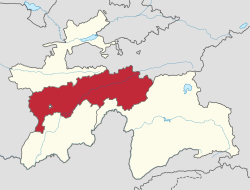Districts under Central Government Jurisdiction
Region of Tajikistan From Wikipedia, the free encyclopedia
Region of Tajikistan From Wikipedia, the free encyclopedia
Districts under Tajikistan Central Government Jurisdiction, also translated as Districts of Republican Subordination or Districts under Republic(an) Subordination (Russian: Районы республиканского подчинения, romanized: Rajony respublikanskogo podchineniya; Tajik: Ноҳияҳои тобеи ҷумҳурӣ, romanized: Nohiyahoyi tobe'i jumhurî, Latin Tajik alphabet: Nohijahoji toвe’i çumhurī), is a region in Tajikistan, consisting of 9 districts and 4 district-level cities that are directly under central administration.[3] Dushanbe, the capital of Tajikistan, is surrounded by the Districts under Central Government Jurisdiction, but not part of it. The region covers an area of 28,500 square kilometres, and has a total population of 2,165,900 (2020).[3] The Districts' ethnic composition in 2010 was 85% Tajik and 11.7% Uzbek.[4]
Districts under Tajikistan Central Government Jurisdiction
Tajik: Ноҳияҳои тобеи ҷумҳурӣ Russian: Районы республиканского подчинения | |
|---|---|
Varzob Ravine | |
 Districts under Central Government Jurisdiction in Tajikistan | |
| Coordinates: 39°0′N 70°0′E | |
| Country | |
| Capital | Dushanbe |
| Area | |
| • Total | 28,500 km2 (11,000 sq mi) |
| Population (2020) | |
| • Total | 2,165,900 |
| • Density | 76/km2 (200/sq mi) |
| ISO 3166 code | TJ-RA |
| HDI (2017) | 0.641[1] medium |
| Official languages | |
After the dissolution of Stalinabad Oblast in 1951, the territories of the former province became directly subordinate to the government of the Tajik SSR, which is how the name came about. In 1955, the Gharm Oblast was dissolved and its territories became subordinate to the Republican Jurisdiction in the same manner. Nowadays, Districts under Central Government Jurisdiction cover much of the territory of those previously dissolved regions, except for Darvoz District which was moved to Gorno-Badakhshan Autonomous Region (when it was still named Qal'ai Khumb district).
The Districts under Central Government Jurisdiction cover 9 districts. The districts are:[3]
The plateau is traversed by the river Vakhsh, a right-hand tributary of the Amu Darya. On the northern border run the Gissar and Zeravshan mountains, and on the southern border the Darvaz range 7,600 metres (24,900 ft). The winter climate is extremely severe: snow begins to fall in October and it is May before it disappears. During the warmer months, however, the mountainsides are richly clothed with the foliage of maple, mountain ash, apple, pear and walnut trees; the orchards furnish not only apples and pears, but peaches, cherries, mulberries and apricots. Both cattle and horses are of a small and hardy breed.[5]
| Year | Pop. | ±% p.a. | ||
|---|---|---|---|---|
| 1979 | 757,976 | — | ||
| 1989 | 1,083,043 | +3.63% | ||
| 1999 | 1,337,479 | +2.13% | ||
| 2010 | 1,722,908 | +2.33% | ||
| 2020 | 2,165,900 | +2.31% | ||
| ||||
| Source: Citypopulation[6] | ||||
Seamless Wikipedia browsing. On steroids.
Every time you click a link to Wikipedia, Wiktionary or Wikiquote in your browser's search results, it will show the modern Wikiwand interface.
Wikiwand extension is a five stars, simple, with minimum permission required to keep your browsing private, safe and transparent.